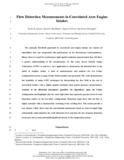JavaScript is disabled for your browser. Some features of this site may not work without it.
| dc.contributor.author | Zachos, Pavlos K. | |
| dc.contributor.author | MacManus, David G. | |
| dc.contributor.author | Chiereghin, Nicola | |
| dc.date.accessioned | 2016-06-24T09:50:29Z | |
| dc.date.available | 2016-06-24T09:50:29Z | |
| dc.date.issued | 2016-07-07 | |
| dc.identifier.citation | Pavlos K. Zachos, David G. MacManus, Daniel Gil Prieto, and Nicola Chiereghin. Flow Distortion Measurements in Convoluted Aeroengine Intakes, AIAA Journal, Vol. 54, No. 9 (2016), pp. 2819-2832 | en_UK |
| dc.identifier.issn | 0001-1452 | |
| dc.identifier.uri | https://dspace.lib.cranfield.ac.uk/handle/1826/10021 | |
| dc.identifier.uri | http://dx.doi.org/10.2514/1.J054904 | |
| dc.description.abstract | The unsteady flowfields generated by convoluted aero engine intakes are major sources of instabilities that can compromise the performance of the downstream turbomachinery components. Hence, there exists a need for high spatial and temporal resolution measurements that will allow a greater understanding of the aerodynamics. Stereoscopic Particle Image Velocimetry is capable of providing such fidelity but its application has been limited previously as the optical access through cylindrical ducts for air flow measurements constitutes a notable pitfall for this type of measurements. This paper presents a suite of S-PIV measurements and flow field analysis in terms of snapshot, statistical and time-averaged measurements for two S-duct configurations across a range of inlet Mach numbers. The flow assessments comprise effects of inlet Mach number and S-duct centerline offset distance. Overall, the work demonstrates the feasibility of using S-PIV techniques for determining the complex flow field at the exit of convoluted intakes with at least two orders of magnitude higher spatial resolution than the traditional pressure rake measurements allow. Analysis of the conventional distortion descriptors quantifies the dependency upon the S-duct configuration and highlights that the more aggressive duct generates twice the levels of swirl distortion than the low offset one. The analysis also shows a weak dependency of the distortion descriptor magnitude upon the inlet Mach number across the entire range of Mach numbers tested. A statistical assessment of the unsteady distortion history over the data acquisition time highlights the dominant swirl patterns of the two configurations. Such an advancement in measurement capability enables a significantly more substantial steady and unsteady flow analyses and highlights the benefits of synchronous high resolution three component velocity measurements to unlock the aerodynamics of complex engine-intake systems. | en_UK |
| dc.language.iso | en | en_UK |
| dc.publisher | American Institute of Aeronautics and Astronautics | en_UK |
| dc.rights | Attribution-NonCommercial 4.0 International | en_UK |
| dc.rights.uri | http://creativecommons.org/licenses/by-nc/4.0/ | |
| dc.title | Flow distortion measurements in convoluted aero engine intakes | en_UK |
| dc.type | Article | en_UK |
| dc.identifier.cris | 3626386 |
Files in this item
This item appears in the following Collection(s)
-
Staff publications (SATM) [4365]

